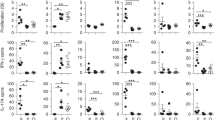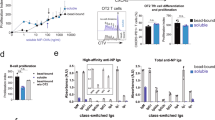Abstract
CHRONICALLY splenectomised animals reflect depressed macrophage activity because the serum immunoglobulins that stimulate them, such as opsonins1–6 and leukophilic γ globulins7–8, are depressed. After splenectomy in animals receiving heterotropic autotransplants of splenic tissue, the tissue fragments (after initial necrosis) are reorganised into structures that are microscopically indistinguishable from the original spleen9–11. These reorganised explants also perform erythrophagocytosis and have been known to protect against Bartonella muris infections that are usually fatal to splenectomised rats. Furthermore, the cells from these explants can exhibit both humoral and cell-mediated immune reactions12. I report here that similar explants of autologous splenic tissue can protect against the deficient opsonin and leukophilic γ globulin activity observed in splenectomised rats.
This is a preview of subscription content, access via your institution
Access options
Subscribe to this journal
Receive 51 print issues and online access
$199.00 per year
only $3.90 per issue
Buy this article
- Purchase on Springer Link
- Instant access to full article PDF
Prices may be subject to local taxes which are calculated during checkout
Similar content being viewed by others
References
Rowley, D. A., J. Immun., 64, 289 (1950).
Shinfield, H. R., Steinberg, C. R., and Kaye, D., J. exp. Med., 123, 777 (1966).
Whittaker, A. N., J. path. Bact., 95, 357 (1968).
Dick T. B., and Gemmel, C. G., J. gen. Microbiol., 4, 153 (1971).
Motohashi, S. J., Med. Res., 43, 473 (1972).
Bogart, D. B., Biggar, W. D., and Good, R. A., J. reticuloend. Soc., 11, 77 (1972).
Fidalgo, B. V., and Najjar, V. A., Proc. natn. Acad. Sci. U.S.A., 57, 957 (1967).
Fidalgo, B. V., and Najjar, V. A., Biochemistry, 6, 3386 (1967).
Manley, O. T., and Marine, D. J., J. exp. Med., 25, 619 (1917).
Perla, D., and Marmorstan-Gottesman, J., J. exp. Med., 52, 131 (1930).
Crosby, W. H., and Benjamin, N. R., Am. J. Path., 39, 109 (1961).
Likhite, V. V., Cell. Immun., 12, 382 (1974).
Rogers, D. E., and Melley, M. A., Yale J. biol. Med., 34, 560 (1962).
Nishioka, K., Satoh, P. S., Constantopolous, A., and Najjar, V. A., Biochim. biophys. Acta, 310, 230 (1973).
Fahey, J. L., J. biol. Chem., 237, 440 (1962).
Fahey, J. L., and Robinson, A. G., J. exp. Med., 118, 845 (1963).
Davis, B. D., Dullsenco, R., Eisen, H. N., Ginsberg, H., and Wood, W. B. (eds) Microbiology, 609 (Harper, Hoeber, New York, 1968).
Rowley, D. A., J. Immun., 65, 515 (1950).
Taliaferro, W. H., and Taliaferro, L. J., J. infect. Dis., 87, 37 (1950).
Hall, J. G., and Morris, B., J. exp. Path., 46, 450 (1965).
Zatz, M. M., and Lance, E. M., J. exp. med., 134, 224 (1971).
Batisto, J. R., Cantor, L. C., Bosek, F., Goldstein, A. L., and Cabrerra, E., Nature 222, 1197 (1969).
Batisto, J. R., Borek, F., and Bucsi, R. A., Cell Immun., 2, 627 (1971)
Lozzio, B. B., Am. J. Phys., 222, 290 (1972).
Lair, S. V., Brown, A., and Lozzio, B. B., Proc. Soc. exp. Biol. Med., 146, 475 1974.
Winkelstein, J. A., and Drodiman, R. H., New Engl. J. Med., 279, 459 (1968).
Johnson, R. B., Newman, S. L., and Struth, A. G., New Engl. J. Med., 288, 803 (1973).
Constantopoulos, A., Najjar, V. A., Wish, J. B., Neccheles, T. H., and Stolhach, L. L., Am. J. Dis. Child., 125, 663 (1963).
Baker, P. J., and Stashak, P. W., J. Immun., 103, 1342 (1963).
Erakalis, A. J., Keny, S. V., Diamond, L. K., and Gross, R. E., New Engl. J. Med., 276, 1225 (1967).
Diamond, L. K., Pediatrics, 43, 88 (1969).
Bisno, A. L., Am. J. med. Sci., 262, 101 (1971).
Rovry, M., Maldanaldo, N., Velez-Garcia, E., Montelvo, J., and Santiago, P. J., Am. int. Med., 77, 11 (1972).
Torres, J., and Biano, A. L., Am. J. Med., 55, 851 (1973).
Author information
Authors and Affiliations
Rights and permissions
About this article
Cite this article
LIKHITE, V. Opsonin and leukophilic γ globulin in chronically splenectomised rats with and without heterotropic autotransplanted splenic tissue. Nature 253, 742–744 (1975). https://doi.org/10.1038/253742a0
Received:
Revised:
Published:
Issue Date:
DOI: https://doi.org/10.1038/253742a0
This article is cited by
-
“How Safe is Splenectomy?”
Irish Journal of Medical Science (1994)
-
Scintigraphic assessment of ectopic splenic tissue localization and function following splenectomy for trauma
European Journal of Nuclear Medicine (1986)
-
Heterotopic autologous splenic grafts in rat
Virchows Archiv A Pathological Anatomy and Histopathology (1986)
-
Regeneration and function of autotransplantation of splenic tissue after splenectomy
World Journal of Surgery (1986)
-
Anatomical approach to the vascular segmentation of the spleen (lien) based on controlled experimental partial splenectomies
Anatomia Clinica (1982)
Comments
By submitting a comment you agree to abide by our Terms and Community Guidelines. If you find something abusive or that does not comply with our terms or guidelines please flag it as inappropriate.



